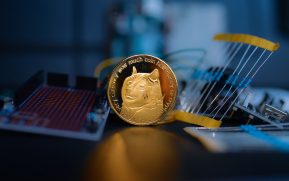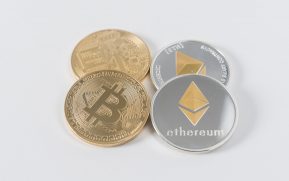
solarseven
Five years ago, I wrote a Seeking Alpha article titled Cryptocurrency Volatility Lessons in which I showed that although cryptos are characterized by high volatility, the volatility was steadily declining. I also showed that cryptos were weakly correlated with equities, offering a desirable portfolio risk reduction possibility. I conjectured that volatility of cryptos would continue to decline, and that, perhaps in five years, a substantial number of investors would be willing to place 1-5% of their portfolios in crypto assets.
This article provides an updated analysis. Some of the earlier lessons still apply, but there have also been some significant changes. My perspective is basically that of an investor primarily interested in equities, but willing to consider the addition of some crypto to his/her portfolio.
In September 2017, Bitcoin (BTC-USD) and Ethereum (ETH-USD) were ranked one and two in terms of market capitalization of the top 10 cryptocurrencies and represented 76% of the total in the top 10. Over the past five years, the market capitalization has increased more than five-fold, from $153.6 billion in 2017 to $771.5 billion today. As of September 2022, Bitcoin and Ethereum still hold the top two spots and represent 69% of the total. Besides Bitcoin and Ethereum only XRP (XRP-USD) (previously known as Ripple) is still in the top 10 list (see Table 1). Seven currencies have been replaced.
Author, Data from Yahoo Finance
With a market capitalization of almost $370 billion, the market capitalization of Bitcoin alone is over twice the market capitalization of all of the cryptos in the top ten list only five years ago. If Bitcoin were a stock, its market cap would put it about 12th in the world (as of October 6, 2022). Jaime Dimon once famously called Bitcoin a fraud (see my Seeking Alpha article titled Bitcoin: A Bubble, Maybe, But Not A Fraud). Interestingly, Bitcoin’s market cap now exceeds that of JPMorgan Chase (JPM).
Three of the newcomers to the top 10 list — Tether (USDT-USD), USD Coin (USDC-USD), and Binance USD (BUSD-USD) are tied to the US Dollar. Since this article focuses on volatility, those three non-volatile currencies will not be discussed further. Also, because data for Solana (SOL-USD) is only available beginning in April 2020, I have omitted it from my analysis. Similar to my previous article, I compare Bitcoin’s volatility to that of other cryptocurrencies, selected stocks, gold, and the US Dollar/Euro exchange rate.
For comparison purposes, the equity assets I have chosen are SPY (SPY) (an ETF that tracks the S&P 500), Apple (AAPL), Amazon (AMZN), Alphabet Class C (GOOG), Alphabet Class A (GOOGL), Meta Platforms (META), Netflix (NFLX), Tesla (TSLA), Block (SQ), Marathon Digital Holdings (MARA), and Riot Blockchain (RIOT). The latter two stocks are engaged in crypto mining. As additional assets, I used SPDR Gold Shares (GLD) and the Euro/US Dollar price. I used prices for the cryptocurrencies only for the same days the stocks traded, which means crypto trading on weekends and holidays was ignored. I included both classes of Alphabet stock, just out of curiosity.
Table 2 recaps return and standard deviation statistics for all the assets. Previously, I analyzed data through August 31, 2017. Since much of the crypto price data I have used in this article began November 9, 2017, there is a slight gap between the two datasets, but I don’t think it impacts any of the broad conclusions. The first two days of price data were needed to compute the first daily return.
The average daily return is a simple average, an arithmetic mean. The compound return is a geometric mean calculated from the beginning and ending prices. For example, TSLA closed at 20.20 on November 9, 2017 and at 275.61 on August 31, 2022. Note: these are split-adjusted prices. The daily (trading day, that is) compound return was 0.299%. This can be annualized using 252 trading days per year to get an annualized return of 72.412%.
Author
As investors know, or should know, volatility hurts compound return. The geometric mean return (the compound return) is always equal to or less than the arithmetic mean return. They are only equal for the special case of no variability. The impact of volatility stands out in Table 2. Cardano (ADA-USD) had an average return of about double that of TSLA. However, the annualized compound returns were similar. Why? ADA’s standard deviation was about 2.4 times greater.
Volatility itself can be volatile. To examine changing volatility, I calculated a 22-day rolling standard deviation. As an example, the standard deviation of daily returns for the period ending December 12, 2017 was calculated using daily returns from November 10-December 12. The calculation for December 13 used returns from November 11-December 13. You can picture this as a moving 22-day window.
Figure 1 shows the standard deviation of daily returns of Bitcoin and SPY from September 2017 through August 2022. Bitcoin’s volatility greatly exceeds that of SPY, especially during certain periods, however the trend, as evidenced by the green line, is down. On the other hand, the trend for SPY, as seen by the red line, is up. Thus, Bitcoin’s relative volatility has decreased. Throughout most of 2022, Bitcoin’s volatility has been 1.8-3.8 times that of SPY. While this is high, in the past there have been periods when it has been more than 10 times higher than SPY.
Author
Figure 2 shows volatility relative to that of SPY for BTC, AAPL, GLD, and the Euro over the one-year period from September 2021-August 2022. A value of 1 means that the given asset’s standard deviation was equal to that of SPY. Since December 2021 both GLD and the Euro have had lower volatility than the SPY (values of relative volatility less than 1) except for one brief period. AAPL’s volatility has generally been about 1.5 times that of SPY.
Author
Relative relationships can be tricky. A huge spike in Bitcoin’s relative volatility on November 18. 2021 can be seen in Figure 2 and yet there is no huge spike in Bitcoin’s absolute volatility on Figure 1 for that same date. Why not? The answer is that SPY’s volatility was quite low at that date, leading to a high relative volatility for BTC. For the period from December 2021 through August 2022, the relative volatilities of all four assets shown in Figure 2 have been fairly stable.
As can be seen from the trend line, Bitcoin’s volatility has continued to decrease over time. The volatility is clearly quite erratic, but the overall trend is downward. Thus, the trend from five years ago has continued.
The three major inputs into Markowitz portfolio theory calculations are returns, standard deviation, and correlations. A key insight of Markowitz’s work was that it is not necessary to have negative correlation between assets to benefit from diversification; there can be benefits even with weak positive correlation. Table 2 shows the correlation matrix for all of the assets, with higher correlations shaded in green and lower correlations in red.
Author
We can see some interesting things just focusing on the shading. The equity assets are in the upper left and are mostly in green with correlations ranging from 0.4 to 0.8 (with the exception of MARA and RIOT). Perfect positive correlation would be +1.000 and perfect negative correlation would be -1.000. Two stocks picked at random from the S&P 500 tend to have correlations between 0.2 and 0.5. The cryptocurrencies also tend to be correlated with each other, with values ranging from 0.4 to 0.7 [except for Dogecoin (DOGE)]. For an equity investor wanting to diversify their portfolio, the lower correlations between stocks and cryptocurrencies looks attractive, especially given the high returns on crypto over the last five years.
The two assets that stand out as exceptions in Table 2 are gold and the euro, which have very low correlations with all of the other assets. From a diversification standpoint, this is attractive, although the returns on these assets over this time period were low, as seen in Table 1.
One of the many things that makes investing difficult is that relationships change over time. Table 3 is the same as Table 2, except it focuses on a recent one-year period. The general pattern is similar, but almost all the correlations are greater than those in Table 2. The main exception is GLD, which has a lower correlation with every other asset aside from BNB.
Author
My main conclusions are:
I would caution investors that there are many different ways to invest in crypto and that there are serious risks with doing so. Table 2 contains an excellent example that shows that not all crypto investments are equal. The compound return on Riot Blockchain, which is a Bitcoin mining company, was negative. I would advise investors to do extensive research before buying any form of crypto.
This article was written by
Disclosure: I/we have a beneficial long position in the shares of BTC-USD, AAPL, AMZN, GOOG, SPY either through stock ownership, options, or other derivatives. I wrote this article myself, and it expresses my own opinions. I am not receiving compensation for it (other than from Seeking Alpha). I have no business relationship with any company whose stock is mentioned in this article.
 How To Make Huge Profits In A Short Time With Crypto
How To Make Huge Profits In A Short Time With CryptoGet detailed training system that shows an absolute beginner (without any skill) how to make huge profits in a short time with crypto.
 Crypto + NFT Quick Start Course
Crypto + NFT Quick Start CourseThe #1 course for profit in the Crypto & NFT world - You will discover the secrets that 99% of people don’t know yet





